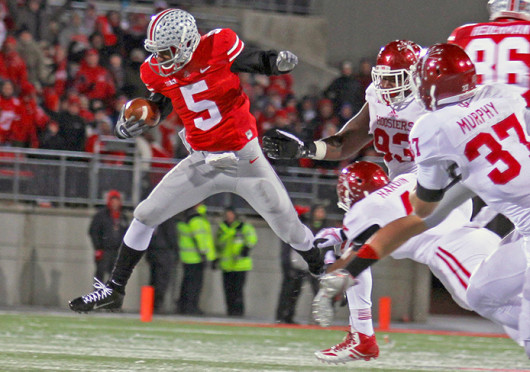
Then-junior quarterback Braxton Miller (5) runs the ball during a game against Indiana Nov. 23 at Ohio Stadium. OSU won, 42-14. On Thursday night, Miller announced that he would be changing positions for the upcoming season. Credit: Lantern file photo
Braxton Miller’s decision to switch positions is a wise one.
The two-time Big Ten Offensive Player of the Year announced Thursday night via SI.com that instead of throwing passes for Ohio State in 2015, he will be catching them.
This decision will primarily help two things.
First, it will make defending the national champions’ offense even more potent.
With either redshirt junior Cardale Jones or redshirt sophomore J.T. Barrett — two players who could start for just about every college team around the nation — as quarterback and junior Ezekiel Elliott in the backfield alongside receivers such as redshirt sophomore Jalin Marshall and junior Dontre Wilson, the Buckeyes were already projected to score points in bunches during the 2015 season.
Now, add Miller to the mix as an H-back — a position that is a cross between running back and wide receiver — and you have the recipe for offense that will be incredibly difficult for defenses around the country to slow down.
But the thing Miller’s decision will help most is his stock in the 2016 NFL draft.
Throughout his first three seasons in Columbus, Miller excelled mightily as a quarterback, compiling a 28-8 record as a starter, along with producing countless highlight plays. Even through all his success, I never believed he had much of a chance to play quarterback at the next level.
His best attribute is his dynamic athleticism, which allows him to make plays with his feet. Whether it was shaking off would-be tacklers to buy more time to find an open receiver or just tucking the ball and running it himself, many of his highlight plays came because of his feet.
His ability to throw is solid at the collegiate level. He can make most of the throws required in coach Urban Meyer’s offense. But in the NFL, his arm would just not cut it. The NFL requires quarterbacks to be able to play from the pocket, which is not a strong skill of Miller’s.
To me, the Huber Heights, Ohio, native is a perfect example of the typical “college quarterback.” His skill set would not translate well to the next level if he tried to continue playing quarterback.
This is why his move to H-back for the Buckeyes in the fall is so wise.
Miller will have all of his redshirt senior season to impress NFL scouts in his new role, unlike a lot of college quarterbacks who transition to a new position after they get drafted or signed by an NFL club.
Numerous former collegiate quarterbacks switch positions at the next level, but Miller’s opportunity to learn that new position and develop his skills before reaching the NFL will set him apart.
For example, Josh Cribbs, formerly of the Cleveland Browns and Indianapolis Colts, played quarterback for Kent State. He was signed as an undrafted free agent by the Browns in 2005 and eventually was converted to play wide receiver and return kicks.
He became an elite kick returner but struggled to grasp his new position as wide receiver. Cribbs never looked comfortable as a receiver. His athleticism was apparent but his route running and hands — two critical attributes required to become an elite receiver — never caught up to his athletic ability.
Had Cribbs been able to spend a collegiate season honing his skills as receiver like Miller will be able to do, maybe he could have developed into something other than a special teams player.
Switching from a position that an individual has played all their life to something entirely brand new once they get to the highest level of competition in the NFL is an uphill climb.
Rather than be stubborn and refuse to switch positions, like Tim Tebow, or wait four seasons to realize that a different position is the best option, like former Buckeye Terrelle Pryor, Miller intelligently opted to get a head start on his climb.
His athletic ability and talent will certainly allow him to make plays at his new position. Getting a season’s worth of experience under his belt before jumping to the NFL will only improve his stock in the upcoming draft.
However, before teams in the NFL have to deal with stopping Miller in his new role, college teams across the nation are charged with that task first.
To those teams, good luck.


